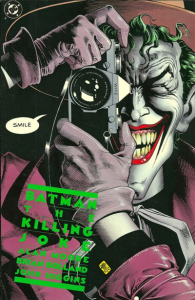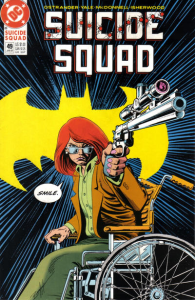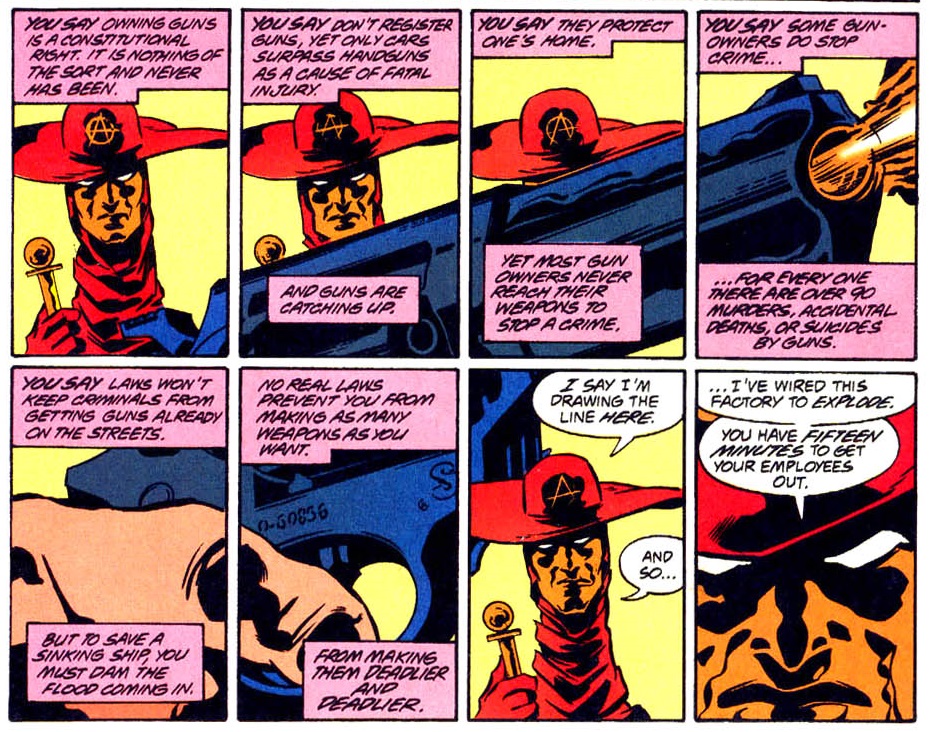
 The Batman Adventures #28
The Batman Adventures #28
While gun control has certainly been a running theme in Batman comics throughout the ages, their relationship with this issue is not as straightforward as some seem to think. I don’t mean Batman’s relationship with gun control in the comics, which is actually relatively clear: he’s an adamant advocate that civilians’ access to firearms should be, at the very least, seriously restricted.
Yes, the Dark Knight – initially a rip-off of the Shadow – carried and used guns in a few of his very early stories, before he got his traumatic origin. Yet I think it’s fair to disregard those as out-of-continuity missteps from a time when the character was still taking shape. (In one of the many intertextual in-jokes of the Brave and the Bold animated show, the magnificent episode ‘Game Over for Owlman!’ recontextualized the image of the Golden Age Dark Knight holding a gun by making him an evil Batman from a parallel Earth.)
As far as the archetypical incarnation of the Caped Crusader goes, it has been firmly set that he hates guns:
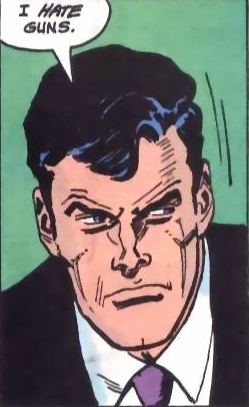 Batman #489
Batman #489
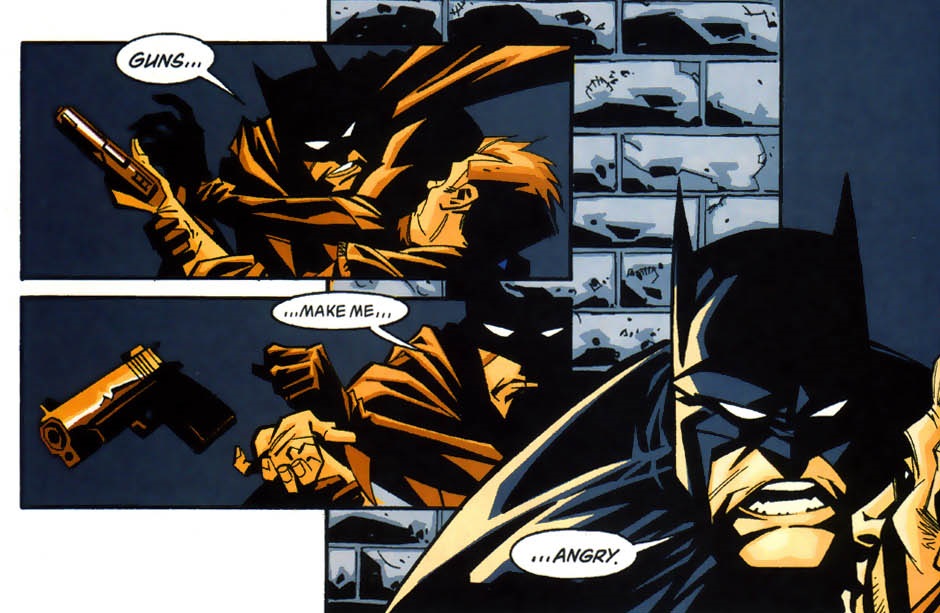 Detective Comics #748
Detective Comics #748
Indeed, busting up gunrunners is – together with beating up drug dealers, muggers, and rapists – a pretty central chunk of Batman’s average nightly activities. In part, this has got to be a calculated move: the Dark Knight knows that, although you can have violent crime and even murder without firepower, access to guns massively amplifies the scale of violence and likelihood of casualties.
Additionally, you can tell the fact that Bruce Wayne saw his own parents gunned down in front of him as a child is always in the back of his mind when he goes after these guys!
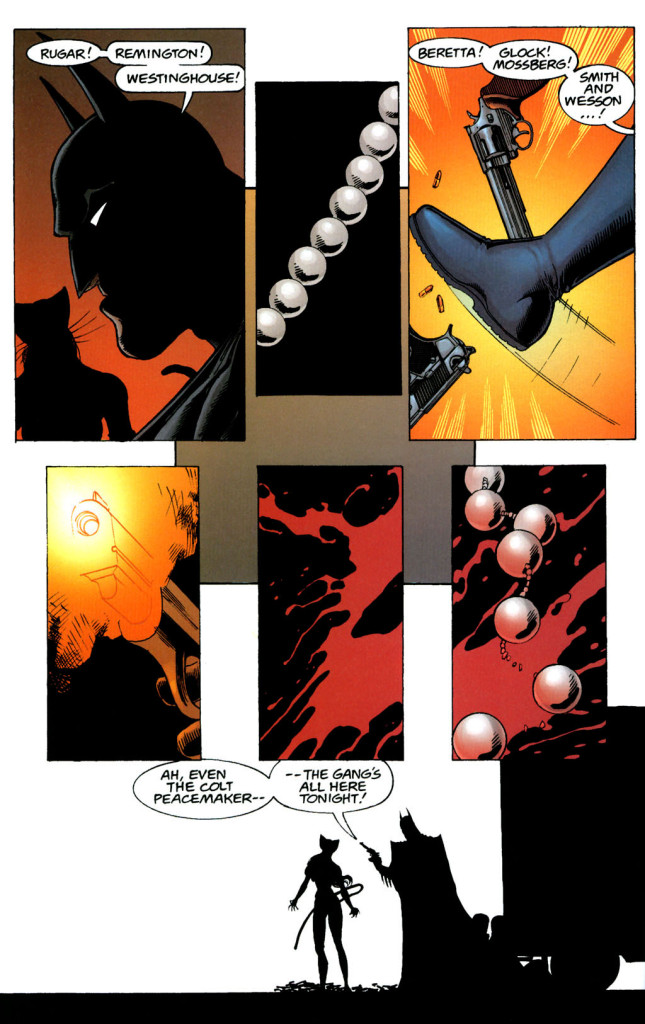 Catwoman: Trail of the Gun #1
Catwoman: Trail of the Gun #1
The anti-gun feeling is up there with ‘no killing’ and the fact that Bruce Wayne is a socially conscious philanthropist (and not just a brutal vigilante) as one of Batman’s most defining character traits.
It’s a trait that, as I’ve argued before, both suits his personality and can serve as a nifty storytelling device, depriving Batman of quick, easy solutions when he’s apparently outmatched in a fight and forcing him to think on his feet. It also plays well with the notion that he’s an outlaw hero: because the Caped Crusader doesn’t carry guns or deploy lethal force, he can come across as an imaginary alternative to the police rather than as an extreme type of cop, terrifying and unbound. Sure, many people consider guns important crimefighting tools, but the whole point of the Batman fantasy is that he’s operating on a whole other level – this is a guy who uses smoke bombs and grappling hooks and batarangs!
That said, there’s still some room for manoeuvre in terms of the Dark Knight’s attitude towards fire weapons. For one thing, even though he despises them, he has made sure he knows how to use them if necessary, as established in ‘The Death Lottery’ (Detective Comics #708-710). And, in particular circumstances, he has been known to exploit guns’ threatening power:
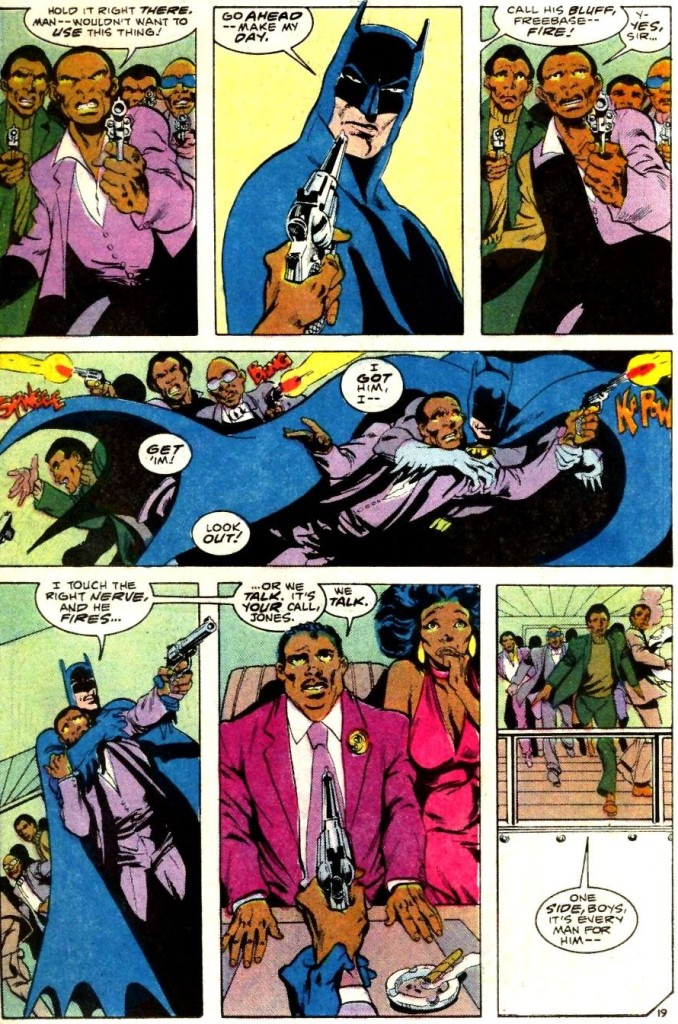 Batman and the Outsiders #28
Batman and the Outsiders #28
Batman’s attitude is not the reason I say his comics don’t always put forth an unambiguous anti-gun message, though. It’s also not because of the fact that, in the 1970s, it was fairly common for those comics to feature ads for toy guns. The main point I want to make is that the Caped Crusader isn’t necessarily the only character in the stories to elicit readers’ sympathies.
Batman’s stance sometimes feels like little more than the idiosyncratic option of one character, which can be counterbalanced by that of others, including that of fan-favorite cops like James Gordon and Renee Montoya, who often save the day by shooting people. Yes, they’re trained officers, but they nevertheless play into the ‘good guy with a gun’ trope – and they generally do it with the Dark Knight’s acquiescence.
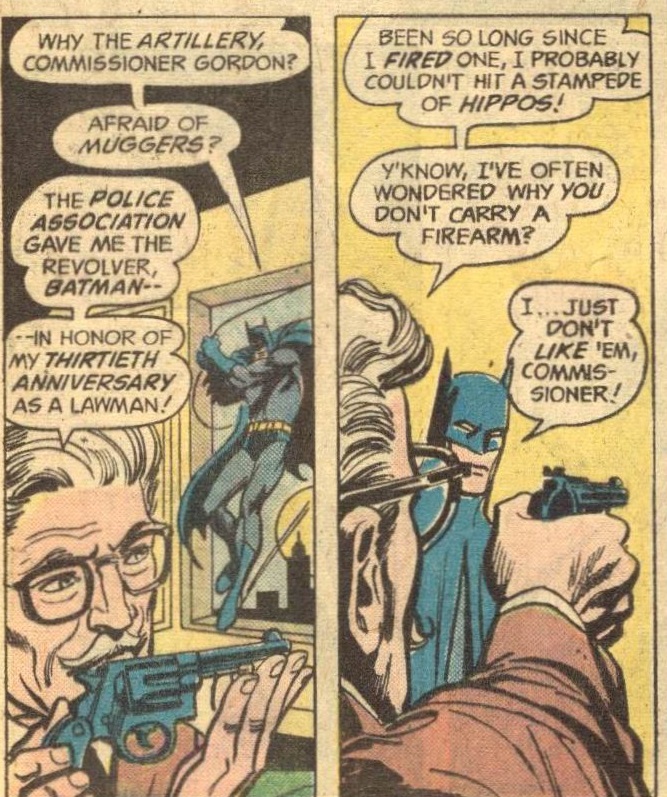 Batman #259
Batman #259
The same goes for Detective Harvey Bullock, although he is typically more of an offbeat cast member – a sort of crummy remnant from an old-school strand of hardboiled fiction, cutting corners and not always on the right side, so not exactly a shiny example of a heroic cop.
Bear in mind, by the way, that this didn’t prevent Doug Moench (who created Bullock back in the 1980s) from giving him a couple of stringent anti-gun lines when trying to convince a robber to drop his weapon:
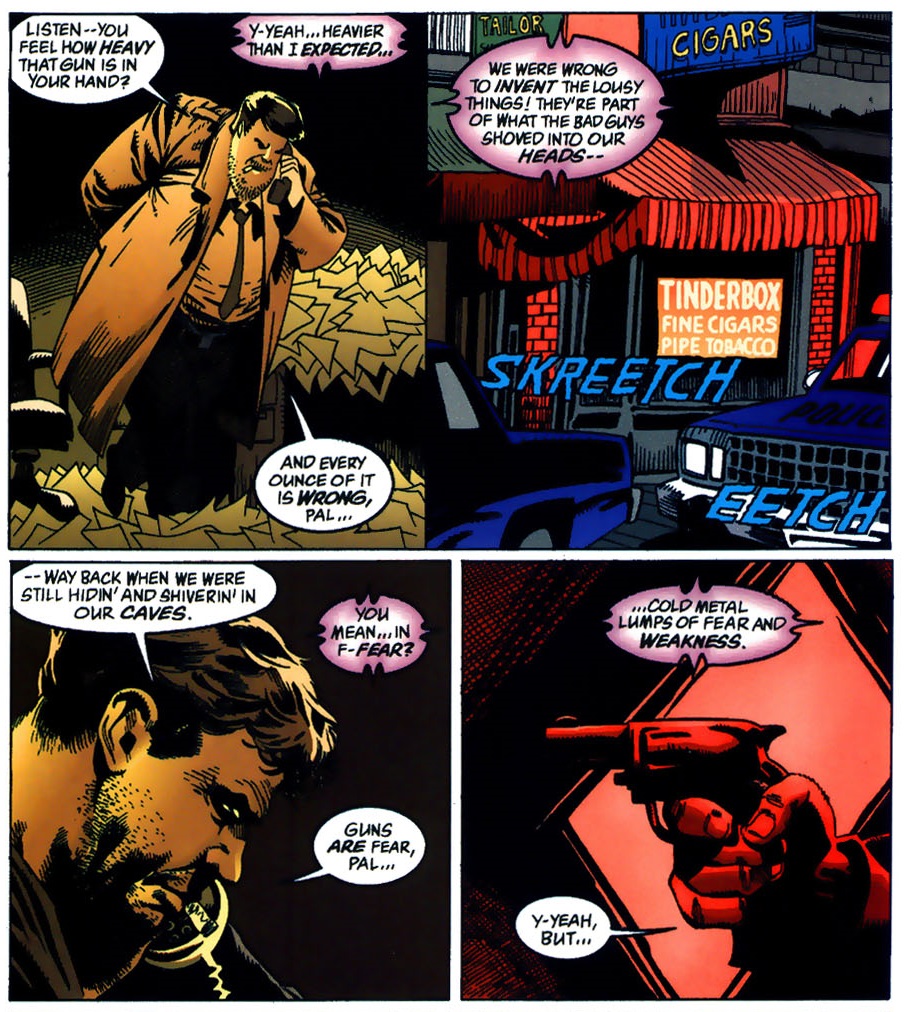 Batman #547
Batman #547
Other sympathetic characters who have prominently displayed very different attitudes towards the gun issue are Barbara Gordon, Sasha Bordeaux, and Alfred Pennyworth. The latter, for example, has been repeatedly shown to own a shotgun and to rely on it for protection whenever he feels particularly threatened…
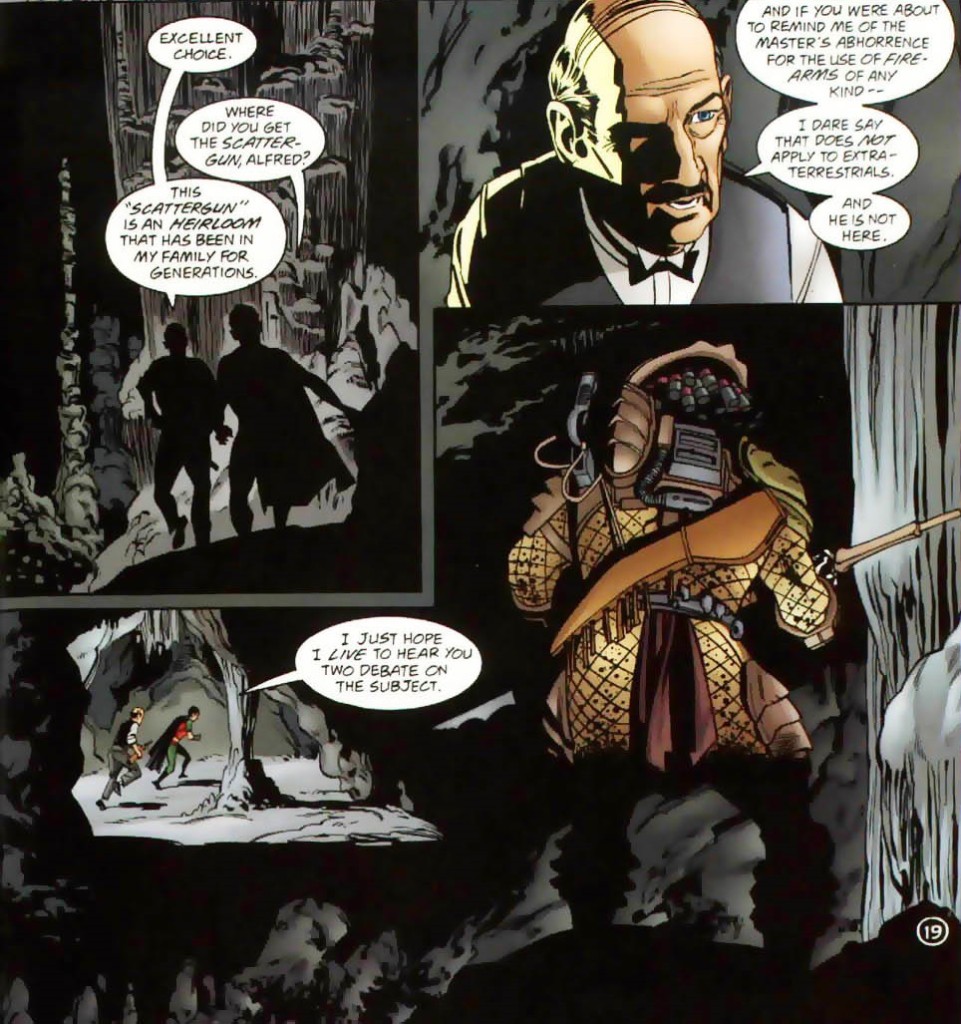 Batman vs Predator III #4
Batman vs Predator III #4
The fact that Alfred Pennyworth uses a shotgun to protect himself and Wayne Manor has been a staple feature of the character at least since the 1990s. It was taken to the extreme in Batman: Earth One (leave it to Geoff Johns to take everything to the extreme), but Chuck Dixon in particular has often reminded readers of this little bit of continuity.
While it is tempting to see in this merely an expression of Chuck Dixon’s famously conservative, gun-totting views, I suspect it comes from another place altogether. After all, if there is one thing Dixon generally excels at, it’s writing characterization, so it’s not too much of a stretch to see this as a character-based decision. It highlights Alfred’s autonomy – not just in the sense of wanting to take care of himself (instead of merely relying on Batman), but also in the sense of displaying a different ethics code than the one from his ‘Master Bruce.’ Moreover, it suggests there is more to Alfred’s background than being a servant (in pre-Crisis continuity, Alfred had been to war, which is something that still pops up in the recent iterations every now and then).
Plus, the contrast between Alfred’s and Bruce’s attitudes can be a recipe for a fun character dynamic…
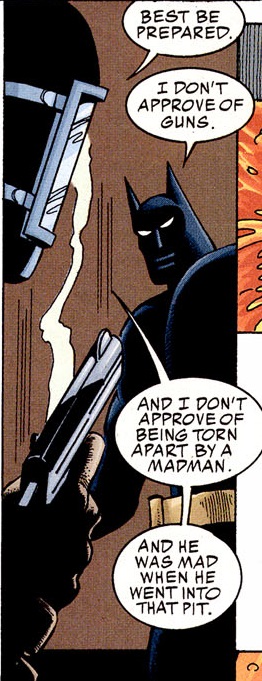 Legends of the Dark Knight #145
Legends of the Dark Knight #145
Going in a whole other direction, Chuck Dixon was behind the creation of a couple of villains whose whole gimmick revolved around their infatuation with firearms: Gunhawk and Gunbunny. Mocking gun culture, he introduced these two deranged snipers in ‘Outgunned’ (Detective Comics #674), which featured a tongue-in-cheek scene at a military expo:

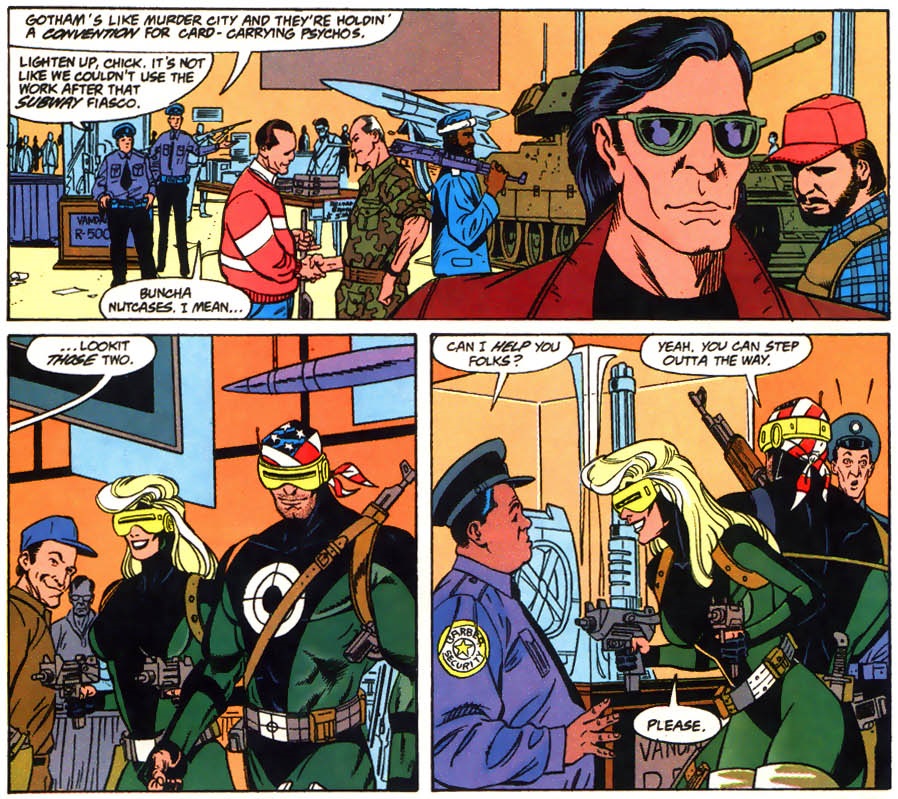 Detective Comics #674
Detective Comics #674
(I’m pretty sure that’s Dixon himself in the top panel…)
Chuck Dixon, in fact, has populated his comics with a number of diverging perspectives, cleverly exploring the cast’s diversity. When writing Robin (Tim Drake), whose crimefighting stems for an admiration for Batman, from a constant desire to do what’s right, and from a general empathy with those around him, Dixon kept the intrinsic reluctance to resort to firearms:

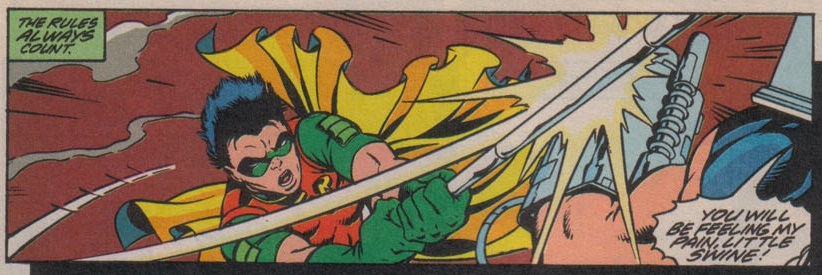 Robin (v4) #14
Robin (v4) #14
Dixon’s excellent run on Robin actually includes one of the most striking tales about this topic. In issue #25 (‘Sophomore Lethal’), Karl Ranck, a jock from Tim Drake’s school, starts packing a handgun to Gotham Heights Highschool because he’s worried about street gangs (to be fair, nobody can deny that Gotham City does have a deeply entrenched, interminable gang problem, what with the Street Demonz, the Wardogs, the Gangstas Nine, the Anti-Batz, the Molehill Mob, and countless others…). That gun gives Karl the misplaced confidence to face a local gangbanger and, sure enough, he ends up getting shot, culminating in a heartbreaking final splash page.
The result is more nuanced than a mere indictment of firearms. At the heart of Dixon’s story appears to be something more specific, namely a concern with school violence and the notion that, no matter how you feel about adults carrying weapons, teenagers certainly lack the necessary maturity. This last point is addressed in a subplot where Tim’s dad confronts Karl’s father, who gave him the gun (for Christmas?) in the first place.
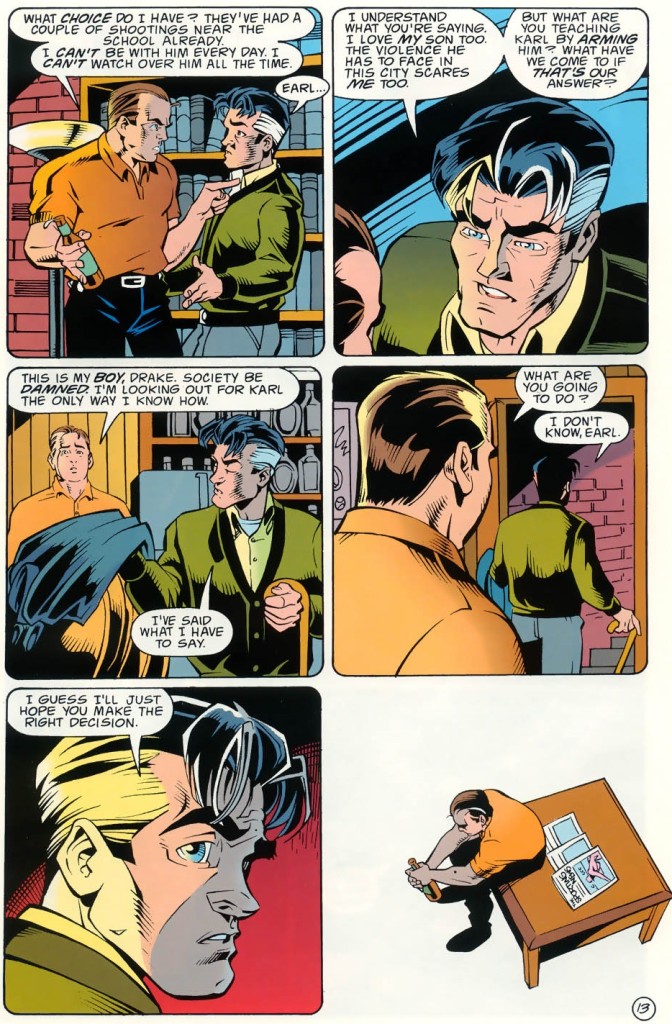 Robin (v4) #25
Robin (v4) #25
I remember reading that Dixon was one of the writers approached by DC to do a gun-control benefit one-shot in the early 1990s, so I’ve always suspected ‘Sophomore Lethal’ was a recycled story idea from that project.
The comic that did come out of that, titled Seduction of the Gun, ended up being written by John Ostrander and illustrated by Vince Giarrano, with a tone that – contrary to what you might expect – is more gritty than sentimental. I won’t pretend like it has the sophistication and poignancy of HBO shows like The Wire or Our Boys, but it’s still a hard-hitting crime yarn, even as it makes a point of discussing various aspects related to firearms in America, such as the implications for the police, for manufacturers, or for teens attending schools where guns are commonplace. There is even a bit about the glorification of guns in mainstream culture that includes jabs at Lethal Weapon and The Punisher:

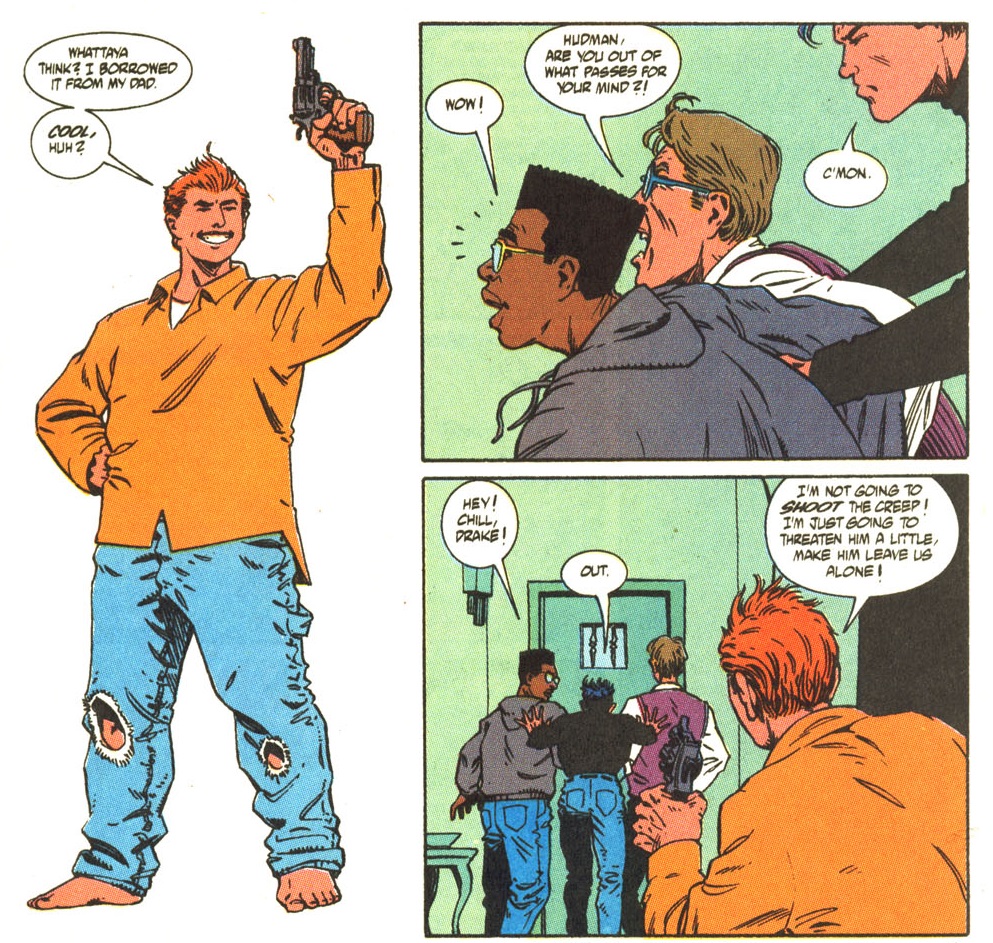 Seduction of the Gun
Seduction of the Gun
In a way, John Ostrander had already approached the issue of gun violence a couple of years before, albeit with quite a different focus. Working with Kim Yale, he had introduced into the pages of Suicide Squad a post-Batgirl Barbara Gordon who had recently lost the use of her legs after getting shot by the Joker in The Killing Joke. Although Barbara was clearly traumatized by those events, she was nevertheless also defined by her pragmatism and rejection of victimization. One issue even had her go on a shooting range in preparation for facing a telepathic psychopath, whom she was thinking about killing – thus turning gunfire from a symbol of her victimhood into a tool of empowerment. She ended up not pulling the trigger on the guy, but the point of the story still stood: Barbara Gordon would take control of her own narrative, refusing the trope of the passive female whose brutalization only serves to advance the male hero’s journey.
Norm Breyfogle’s cover for that issue effectively illustrated this perspective by sort of reversing the POV of Brian Bolland’s classic cover for The Killing Joke:
This strong – if sometimes conflicted – characterization of Barbara Gordon was later picked up by writers Chuck Dixon and Devin K. Grayson. For instance, when her dad was shot, Barbara kept her cool while handling the investigation. Grayson made a point of showing readers that Babs knew her stuff when it came to firearms, which she didn’t treat as a taboo:
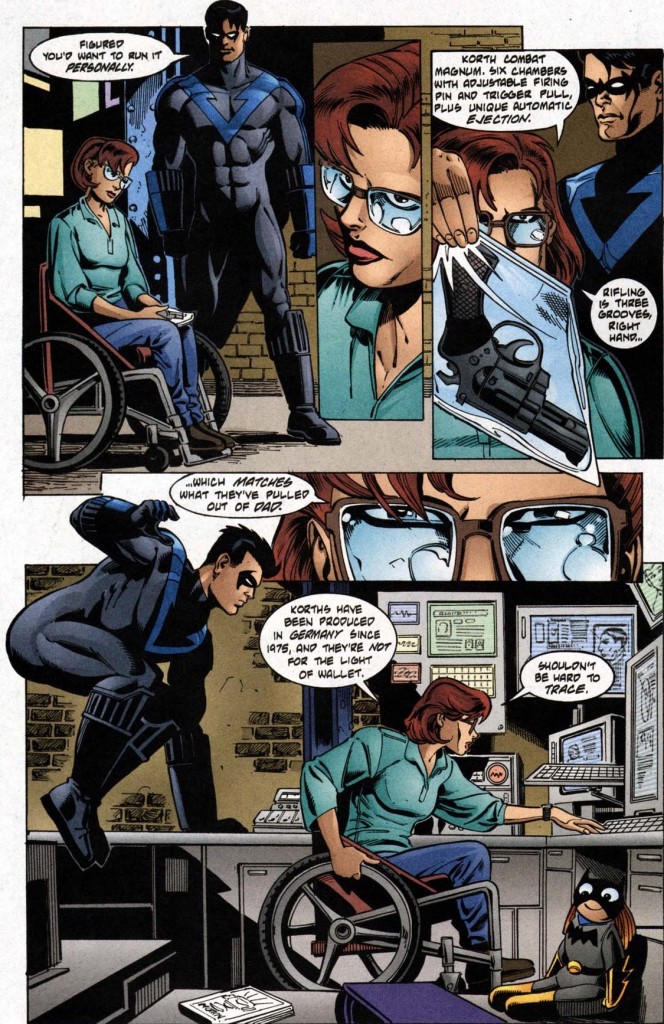 Nightwing #53
Nightwing #53
Curiously, around that time, in the alternative continuity of Gotham Adventures, Ty Templeton also went to Barbara Gordon in order to briefly tackle the misleading sense of power and safety that weapons can provide. That version of the character hadn’t been shot, so she was still Batgirl and she tagged along with the Dark Knight when he went to Tibet in search of the hidden headquarters of the League of Assassins. Because it was such a dangerous mission, however, Barbara decided to arm herself, leading to a few tense exchanges with Batman along the way.
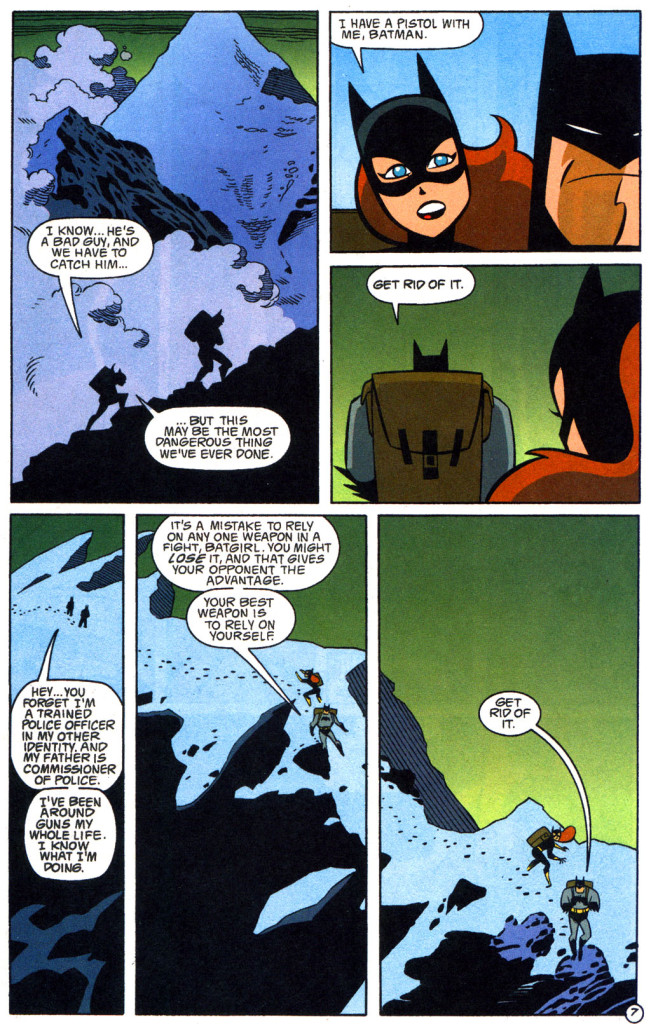 Gotham Adventures #9
Gotham Adventures #9
Spoilers: in the end, Batman was proven right. Relying on a gun meant that Barbara put herself in a position where, once disarmed, she basically gave her adversary access to a fire weapon, which he could then turn against her (fortunately for her, he was a martial artist who preferred to fight with his fists anyway!). The comic didn’t come across as too preachy, though, because the discussion was neatly integrated into the story and, more importantly, into believable character dynamics.
Likewise, it made perfect sense that Batman would discuss the issue with Sasha Bordeaux, Bruce Wayne’s short-lived bodyguard from the early 2000s. Those conversations had a whole other slant, however. Writer Ed Brubaker used them to criticize facile gun control rhetoric as well as to point out the childlike logic of Batman’s general worldview…
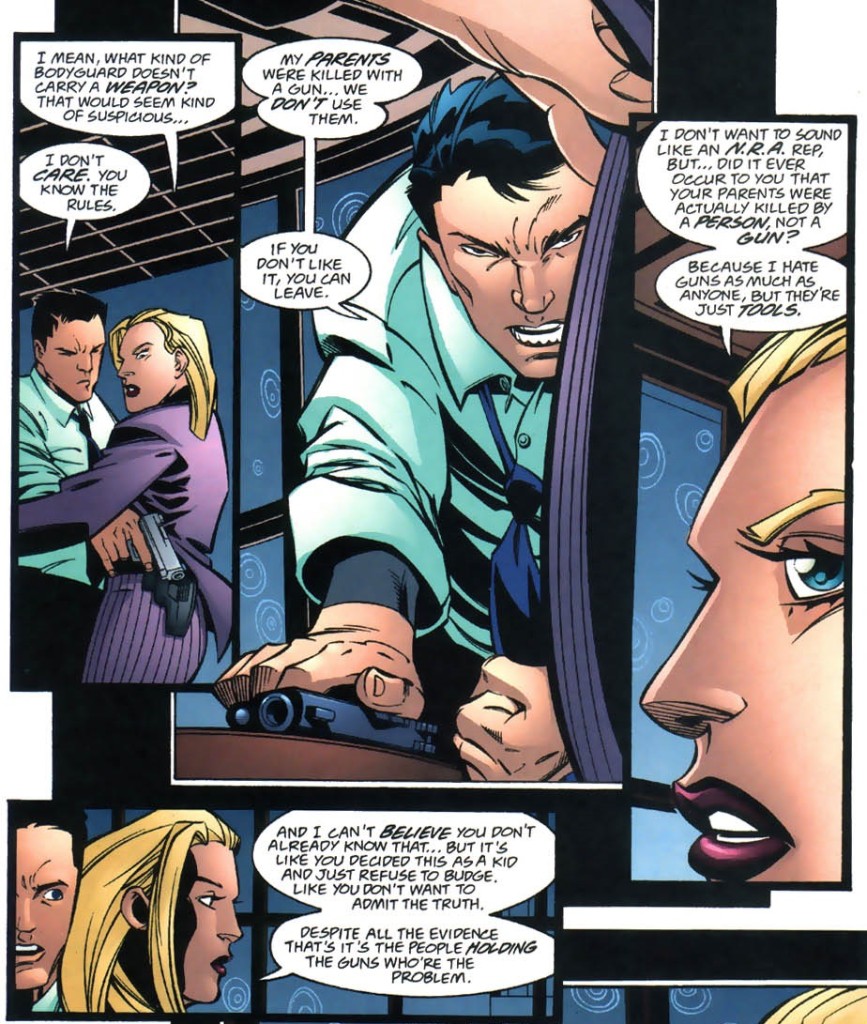 Batman #595
Batman #595
This story, ‘Out of the Past,’ is consistent with Ed Brubaker’s overall comics-writing agenda, which has typically targeted a relatively mature readership, imbuing even superhero books with a pseudo-realistic sensibility (even if, in his Batman run, Brubaker’s style was uncomfortably at odds with the exaggerated, lighter art of Scott McDaniel). Thus, while Bruce Wayne did get the final word, he didn’t change Sasha Bordeaux’s mind. In the end, the comic still seemed to stress that there was something grown-up about her position.
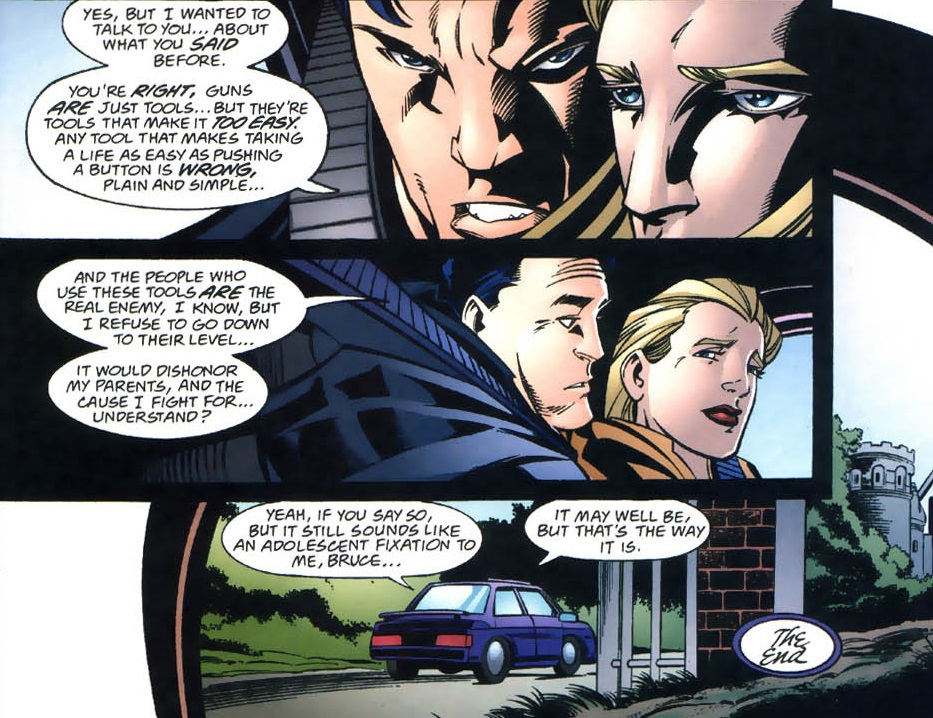 Batman #595
Batman #595
I don’t know if they were originally designed to play off each other, but this issue ended up tying in with ‘The Devil You Know’ (Gotham Knights #24), which was published a few months after ‘Out of the Past’ (yet set only a week later). Using a device similar to the one in Darwyn Cooke’s then-recent Ego one-shot, Devin Grayson built ‘The Devil You Know’ around a conversation between Bruce Wayne and a psychological projection of Batman, who taunted him about his phobia of firearms. In line with the turn-of-the-millennium’s typical characterization of the Dark Knight as mentally unstable and stuck in a narcissistic state of arrested development, the comic suggested not only that Bruce had a split personality, but also that his relationship with guns stemmed as much from an unhealthy, irrational fear as from more practical and/or ideological arguments.
‘The Devil You Know’ was an introspective tale with some nice visual storytelling (Roger Robinson and John Floyd made for a fine art team, even if their work paled in comparison to Cooke’s approach to this kind of narrative in Ego), which also fitted in terms of the grander Batman narrative: on the one hand, Bruce’s self-doubt could be read as a fallout from his argument with Sasha Bordeaux in ‘Out of the Past;’ on the other hand, Bruce’s decision to purchase a weapon served to set up a plot point for the upcoming Bruce Wayne: Murderer? crossover (and to reinforce the shocking dimension of Bruce’s accusation in that storyline). While I’m not in love with either of these tales, I appreciate that Brubaker and Grayson sought to work in a discussion of the gun issue in ways that felt interesting and organic to the Batman franchise.
By contrast, 2004’s Catwoman: Trail of the Gun mostly addressed the topic by having Catwoman watch television:

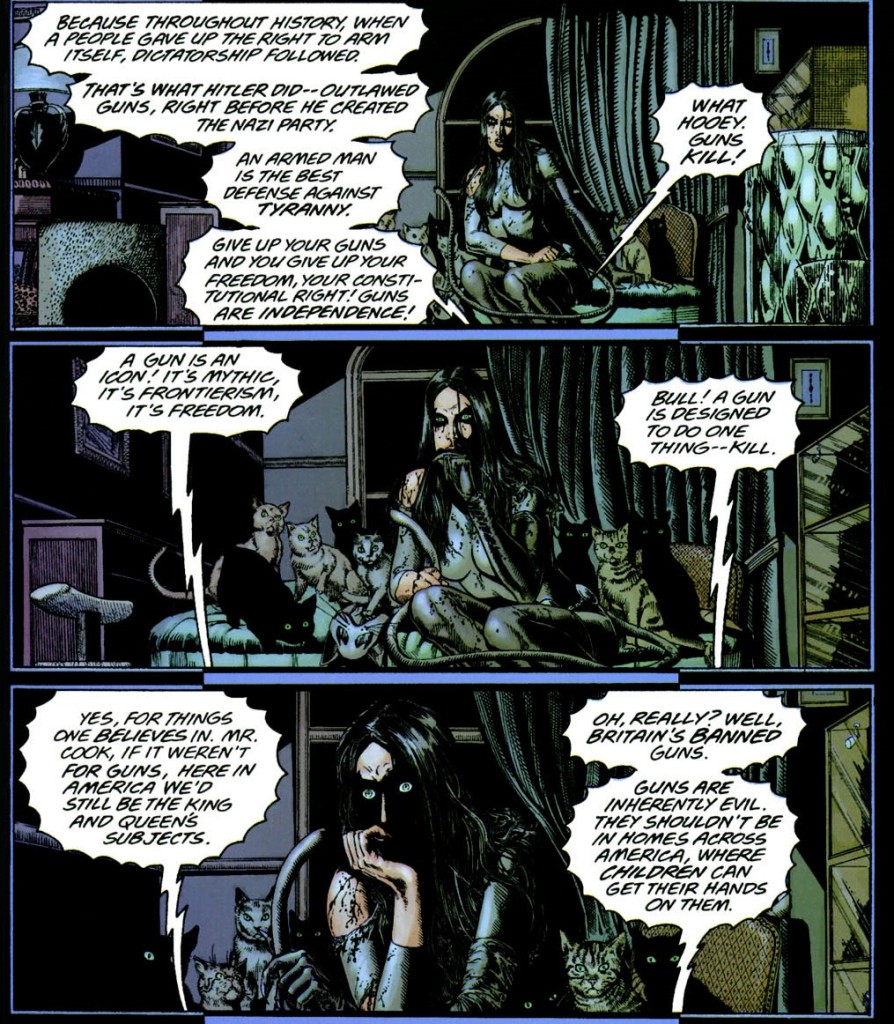 Catwoman: Trail of the Gun #1
Catwoman: Trail of the Gun #1
Sure, there is also a convoluted story about Catwoman searching for a one-of-a-kind ‘smart gun’ that can revolutionize fire weapons. Seriously, though, a huge chunk of this prestige two-parter is little more than a comic about Selina Kyle watching TV. It’s almost postmodern, in a way, eschewing the plot for pages in a row while trying to mimic the experience of following televised debates about gun control.
At least in The Dark Knight Returns, Frank Miller’s use of talking heads on TV screens had a playfulness and a sense of crescendo, moving the story forward in an original (at the time) and entertaining way. Trail of the Gun, however, seems so devoid of irony that it actually makes you feel like you’re just watching mainstream television. And not even watching engaging contributions like the Bowling for Columbine documentary, but the blandest, most generic news programs that happen to be on:
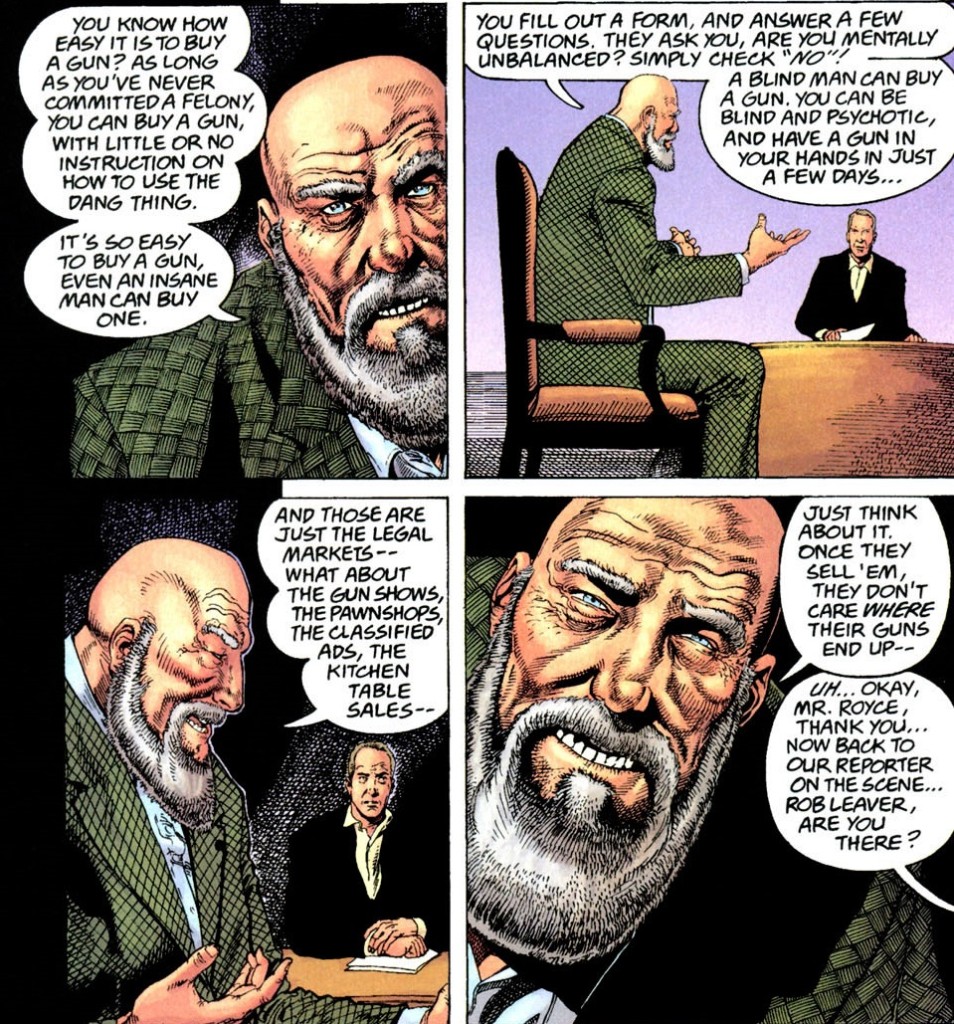 Catwoman: Trail of the Gun #1
Catwoman: Trail of the Gun #1
Generally, I’m quite the fan of Ann Nocenti’s sensationalistic writing style (especially in her Daredevil run), but Trail of the Gun is a surprisingly painful slog. Despite the liberal slant, it’s one of those comics that tries to ‘show both sides’ of the argument, so the dialogues are full of hamfisted statements about the central topic – one character will say that ‘guns are for jerks and cowards,’ the other will explain that in his milieu ‘guns are the great equalizer,’ eventually someone will conclude that ‘guns empower people that have no power,’ etc. Practically every exchange is an explicit comment about some aspect of gun control, from the argument that manufacturers should be accountable to the charge that references to the 2nd Amendment are ultimately disingenuous and unproductive.
Mind you, I largely agree with many of the points made in Trail of the Gun (a few of them are even quite thought-provoking). I just wish Nocenti could’ve found a more appealing way to put them across than to just have characters spout them at each other all the time…
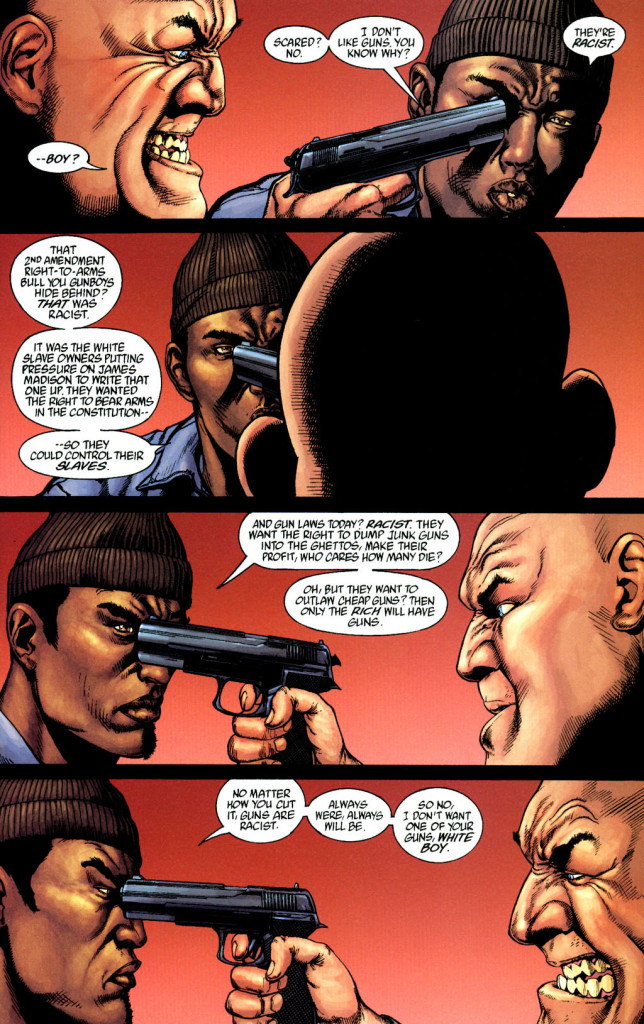 Catwoman: Trail of the Gun #2
Catwoman: Trail of the Gun #2
(Trail of the Gun is also a waste of Ethan van Sciver’s talent as an artist… Given his over-the-top reactionary politics, however, I do find it amusing to see him try to visually salvage such a liberal project.)
I’m not saying you cannot directly thematize the issue of gun control in mainstream comics. For instance, Saga of the Swamp Thing #45 (‘Ghost Dance’), with its EC-style haunted house tale based on the Winchester Mansion, remains a powerful and original visualization of the weight of firearms in American history. Hell, even ‘Forgotten Paths,’ a comic in which Green Arrow travelled to Gotham City and met a bunch of victims of gun violence, isn’t all that bad, although perhaps I just feel this way because I have a soft spot for Anarky…

